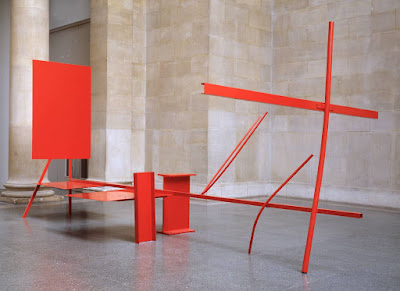Sir Anthony Alfred Caro (8 March 1924 – 23 October 2013) was an English abstract sculptor whose work is characterised by assemblages of metal using 'found' industrial objects.His style was of the modernist school, having worked with Henry Moore early in his career.He was lauded as the greatest British sculptor of his generation
Anthony Caro encountered modernism when working as an assistant to Henry Moore in the 1950s. After being introduced to the American sculptor David Smith in the early 1960s, he abandoned his earlier figurative work and started constructing sculptures by welding or bolting together pieces of steel such as I-beams, steel plates and meshes. Often the finished piece was then painted in a bold flat colour.
Caro found international success in the late 1950s. He is often credited with the significant innovation of removing the sculpture from its plinth, although Smith and Brâncuși had both previously taken steps in the same direction. Caro's sculptures are usually self-supporting and sit directly on the floor. In doing so, they remove a barrier between the work and the viewer, who is invited to approach and interact with the sculpture from all sides.
In 1982 Caro was trying to organise an exhibition of British abstract art in South African townships when he met Robert Loder. In 1981, when staying in New York State, the pair developed the idea of running workshops for professional artists, which became the Triangle Arts Trust. They held the first Triangle workshop in 1982 for thirty sculptors and painters from the US, the UK and Canada at Pine Plains, New York.
In the 1980s Caro's work changed direction with the introduction of more literal elements, with a series of figures drawn from classical Greece. After visiting Greece in 1985, and closely studying classical friezes, he embarked on a series of large-scale narrative works, including After Olympia, a panorama more than 23 metres (75 ft) long, inspired by the temple to Zeus at Olympia.Latterly he has attempted large scale installation pieces, one of which, Sea Music, stands on the quay at Poole, Dorset.Wikipedia
In the 1980s Caro's work changed direction with the introduction of more literal elements, with a series of figures drawn from classical Greece. After visiting Greece in 1985, and closely studying classical friezes, he embarked on a series of large-scale narrative works, including After Olympia, a panorama more than 23 metres (75 ft) long, inspired by the temple to Zeus at Olympia.Latterly he has attempted large scale installation pieces, one of which, Sea Music, stands on the quay at Poole, Dorset.Wikipedia









No comments:
Post a Comment